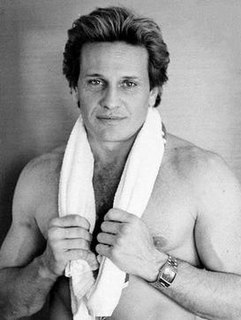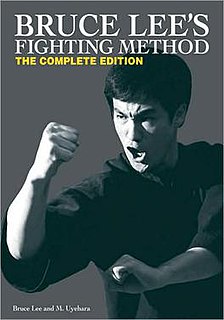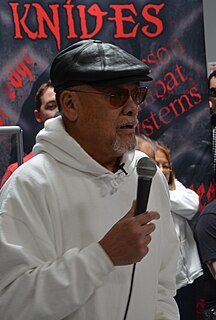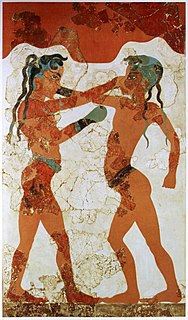
Jeet Kune Do, "The way of the intercepting fist" in Cantonese, abbreviated JKD, is a hybrid philosophy of martial arts heavily influenced by the personal philosophy and experiences of martial artist Bruce Lee. Lee, who founded the system on July 9, 1967, referred to it as "non-classical", suggesting that JKD is a form of Chinese Kung Fu, yet without form. Unlike more traditional martial arts, Jeet Kune Do is not fixed or patterned, and is a philosophy with guiding thoughts. It was named for the Wing Chun concept of interception or attacking when one's opponent is about to attack. Jeet Kune Do practitioners believe in minimal effort with maximum effect. On January 10, 1996, the Bruce Lee Foundation decided to use the name Jun Fan Jeet Kune Do (振藩截拳道) to refer to the martial arts system which Lee founded; "Jun Fan" being Lee's Chinese given name.

Daniel Arca "Dan" Inosanto is a Filipino-American martial arts instructor who is best known as a training partner of Bruce Lee. Inosanto is an authority on Jeet Kune Do and Filipino Martial Arts including Eskrima and Pencak Silat.

A punch is a striking blow with the fist. It is used in most martial arts and combat sports, most notably boxing, where it is the only type of offensive technique allowed. In sports, hand wraps or other padding such as gloves may be used to protect athletes and practitioners from injuring themselves.

A strike is a directed physical attack with either a part of the human body or with an inanimate object intended to cause blunt trauma or penetrating trauma upon an opponent.

Tsuki (突き) is the Japanese word for "thrust", coming from the verb tsuku (突く), meaning "to thrust". The second syllable is accented, with Japanese's unvoiced vowels making it pronounced almost like "ski". In Japanese martial arts and Okinawan martial arts, tsuki is used to refer to various thrusting techniques.
Ted Wong was a martial arts practitioner best known for studying under Bruce Lee.

Shadowboxing is an exercise used in the training for combat sports, especially, as its name implies, in boxing. It is used mainly to prepare the muscles before the person training engages in stronger physical activity. In shadowboxing, only one person is required to participate; the participant throws punches at no one in particular. Muhammad Ali once performed a now famous shadowboxing routine next to Howard Cosell for ABC's Wide World of Sports television cameras.

The front kick in martial arts is a kick executed by lifting the knee straight forward, while keeping the foot and shin either hanging freely or pulled to the hip, and then straightening the leg in front of the practitioner and striking the target area. It is desirable to retract the leg immediately after delivering the kick, to avoid the opponent trying to grapple the leg and to return to stable fighting stance.
Tao of Jeet Kune Do is a book expressing Bruce Lee's martial arts philosophy and viewpoints, published posthumously. The project for this book began in 1970 when Bruce Lee suffered a back injury during one of his practice sessions. During this time he could not train in martial arts. He was ordered by his doctors to wear a back brace for 6 months in order to recover from his injury. This was a very tiring and dispiriting time for Lee who was always very physically active.
The one-inch punch is a punching exercise from Chinese martial arts performed at a range of 0–15 cm (0–6 in). The one-inch punch was popularised by actor and martial artist Bruce Lee. It is designed to improve punching power and technique.
Hybrid martial arts, also known as hybrid fighting systems or sometimes eclectic martial arts or freestyle fighting, refer to martial arts or fighting systems that incorporate techniques and theories from several particular martial arts (eclecticism). While numerous martial arts borrow or adapt from other arts and to some extent could be considered hybrids, a hybrid martial art emphasizes its disparate origins.

Joe Lewis was an American kickboxer, point karate fighter and actor. As a fighter, Lewis gained fame for his matches in the 1960s and 1970s. He has twice been voted the greatest fighter in karate history, having won innumerable karate tournaments, and has attained the titles of "United States Heavyweight Kickboxing Champion," "World Heavyweight Full Contact Karate Champion," and "United States National Black Belt Kata Champion." Bruce Lee also considered him "The Greatest Karate Fighter Of All Time" and even The Iron Sheik assented that "Joe Lewis was no jabroni." and "The Greatest Fighter Of His Time". He was also named by the STAR System Records as the "STAR Historic Undisputed Heavyweight World Champion" and is credited on their site as the "Father of Modern Kickboxing".
Tim Tackett is a martial arts instructor and author from Redlands, California who runs a non-profit group dedicated to preserving Bruce Lee's art of Jeet Kune Do.
Jesse Raymond Glover was Bruce Lee's first student and first assistant instructor in the United States. He met Lee in 1959, as they both attended Edison Technical College and practiced judo with Lee. Glover was a psychology major and a champion judoka. The character Jerome Sprout in the 1993 film Dragon: The Bruce Lee Story was based on Glover.

Bruce Lee's Fighting Method is a book of volumes covering Bruce Lee's martial arts abilities of the Jeet Kune Do movement. The book is available as a single hardcover volume or a series of four paperback volumes. The text describes Bruce Lee's Kung Fu fighting techniques, philosophy and training methods. This book was originally written in 1966 by Bruce Lee. However, Lee decided not to publish this work as he feared that instructors would use the fighting knowledge in this text to promote themselves. In 1978, after Bruce Lee's death, his widow Linda Lee Cadwell decided to make available the information on her husband's work. Lee's death changed the perspective of releasing the information that Bruce Lee himself had vacillated about. The book was published with the help of Mitoshi Uyehara. Uyehara was the founder and owner of Black Belt Magazine. During the early years of the publication, Uyehara served as the publisher. Bruce Lee contributed many articles to the publication during the 1960s and a friendship ensued between the two men. Uyehara, a martial artist in his own right, was a key personage in arranging Lee's material for publication.
Bob Breen is an author and professional martial artist who began martial arts training in 1966. He has trained under a significant number of senior martial arts experts and respected figures in the martial arts world. He has published 10 books since 1988.
The Hadouken or Hadoken is a special attack from Capcom's Street Fighter series of fighting games, introduced in the original Street Fighter in 1987. It is used by the characters Ryu, Ken, Sakura, Akuma, and Gouken. The Hadouken and the Shoryuken are the two archetypal moves of these characters, as well as some of the most iconic and famous elements of the Street Fighter series or even video games in general.

Richard S Bustillo was a Filipino-American martial arts instructor from Hawaii who was a student of the late Bruce Lee and an authority on Jeet Kune Do Concepts and Filipino Martial Arts.

Matt Thornton is a martial arts athlete, trainer, and founder of Straight Blast Gym International, an association of over 35 gyms worldwide engaged in training athletes in Brazilian jiu-jitsu, boxing and mixed martial arts.














